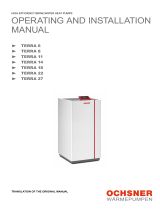
2 | WPC | WPC cool www.stiebel-eltron.com
CONTENTS
SPECIAL INFORMATION
OPERATION
1. General information _________________________________________4
1.1 Relevant documents_____________________________________________ 4
1.2 Safety instructions _______________________________________________ 4
1.3 Other symbols in this documentation _______________________ 4
1.4 Information on the appliance _________________________________ 4
1.5 Units of measurement __________________________________________ 4
1.6 Standardised output data ______________________________________ 5
2. Safety __________________________________________________________ 5
2.1 Intended use ______________________________________________________ 5
2.2 Safety instructions _______________________________________________ 5
2.3 Test symbols ______________________________________________________ 5
3. Appliance description _______________________________________5
3.1 Special features of the WPC...cool ____________________________ 6
3.2 Accessories ________________________________________________________ 6
4. Operation _____________________________________________________7
4.1 Controls ____________________________________________________________ 7
4.2 Entering parameters ____________________________________________ 8
4.3 Selecting operating modes ____________________________________ 9
4.4 Picture symbols __________________________________________________ 9
5. Menu structure _____________________________________________ 10
INFO _______________________________________________________________ 10
DIAGNOSIS _______________________________________________________ 12
PROGRAMS ______________________________________________________ 13
SETTINGS _________________________________________________________ 15
6. Maintenance and care _____________________________________ 21
7. Troubleshooting ____________________________________________ 21
7.1 Other problems _________________________________________________ 21
INSTALLATION
8. Safety ________________________________________________________ 22
8.1 General safety instructions ___________________________________ 22
8.2 Instructions, standards and regulations ___________________ 22
9. Appliance description _____________________________________ 22
9.1 Mode of operation ______________________________________________ 22
9.2 Special features of the WPC...cool ___________________________ 22
9.3 Standard delivery _______________________________________________ 22
9.4 Accessories _______________________________________________________ 22
10. Preparations ________________________________________________ 22
10.1 Minimum clearances ___________________________________________ 23
10.2 Electrical installation___________________________________________ 23
11. Installation __________________________________________________ 23
11.1 Transport _________________________________________________________ 23
11.2 Siting ______________________________________________________________ 25
11.3 Align the side casing ___________________________________________ 26
11.4 Opening the appliance _________________________________________ 26
11.5 Installing the heat source system ___________________________ 26
11.6 Heating water connection _____________________________________ 27
11.7 Oxygen diffusion ________________________________________________ 28
11.8 Filling the heating system ____________________________________ 28
11.9 Venting the heating system ___________________________________ 29
11.10 DHW connection ________________________________________________ 29
11.11 DHW circulation connection __________________________________ 29
11.12 Operation with buffer cylinder _______________________________ 30
11.13 Fitting the push-fit connectors _______________________________30
12. Power supply _______________________________________________ 32
12.1 General ___________________________________________________________ 32
12.2 Power supply ____________________________________________________ 32
12.3 Sensor installation ______________________________________________34
12.4 Safety temperature controller for underfloor heating
system STB-FB __________________________________________________34
12.5 FE7 remote control _____________________________________________34
12.6 FEK remote control _____________________________________________ 35
12.7 Uponor DEM WP module ______________________________________ 35
12.8 Internet Service Gateway ISG ________________________________ 35
13. Commissioning _____________________________________________ 35
13.1 Checks before commissioning________________________________ 35
13.2 Heating curve adjustment during commissioning _______ 36
COMMISSIONING ________________________________________________ 36
13.3 WPM3i commissioning report ________________________________ 39
14. Settings _____________________________________________________ 41
14.1 Standard settings _______________________________________________ 41
14.2 Heating and DHW programs __________________________________ 41
14.3 Appliance handover ____________________________________________ 41
15. Shutting down ______________________________________________ 42
16. Troubleshooting ____________________________________________ 42
16.1 Fault display _____________________________________________________ 42
16.2 Fault message ___________________________________________________ 42
16.3 Resetting the high limit safety cut-out _____________________ 43
16.4 Resetting the compressor high limit safety cut-out _____ 43
16.5 Fault table ________________________________________________________44
17. Maintenance ________________________________________________ 45
17.1 DHW cylinders ___________________________________________________ 45
18. Specification ________________________________________________ 47
18.1 Dimensions and connections _________________________________ 47
18.2 Wiring diagram WPC 04 | WPC 04 cool | WPC 05 | WPC
05 cool ____________________________________________________________48
18.3 Wiring diagram WPC 07 | WPC 07 cool | WPC 10 | WPC
10 cool | WPC 13 | WPC 13 cool_______________________________ 50
18.4 Output diagrams WPC 04 | WPC 04 cool ____________________ 52
18.5 Output diagrams WPC 05 | WPC 05 cool ____________________ 54
18.6 Output diagrams WPC 07 | WPC 07 cool ____________________ 56
18.7 Output diagrams WPC 10 | WPC 10 cool ____________________ 58
18.8 Output diagrams WPC 13 | WPC 13 cool ____________________ 60
18.9 Data table WPC ... ______________________________________________ 62
18.10 Data table WPC ... cool ________________________________________ 64
GUARANTEE
ENVIRONMENT AND RECYCLING




















